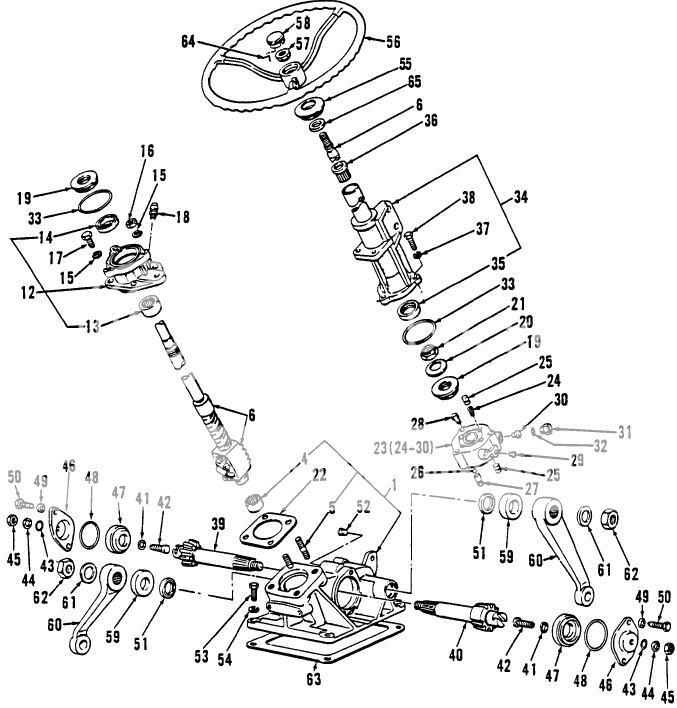RandomEmployee
New User
Hi guys.
I'm employed by a small town out in the middle of nowhere, and among other things I have the (at times dubious) pleasure of maintaining an old Ford 3000.
When cold weather hit, the hydraulics became a shuddery, nearly-useless mess. Roughly the same time, one of the rigid steel lines running to the right-hand steering cylinder snapped off at the end and the fluid emptied before I realized I no longer had assist.
This evening, I finally got around to draining and replacing the main hydraulic and transmission fluids, and replaced the steel line with a rubber one fabricated by a local shop.
Main hydraulics are now working smoothly and strongly, and the transmission is shifting better now - their previous fluids appeared to be used motor oil and melted vanilla ice cream, respectively - but the steering is acting oddly. Basically, the power assist is working fine for the most part, but there's a spot around centered (seems very slightly to the left) where the assist stiffens up, then "pops" and continues on just fine. Almost feels like it's catching on something.
Normally I wouldn't really care, but when it pops, the steering jerks, usually to the left. This is more than a tad bit dangerous at speed, since it occasionally happens when I'm making normal steering adjustments...we have paved roads around here, but they're not in the best of shape.
The steering hydraulics were working perfectly prior to the line break, with smooth movement throughout the range. It has mechanical issues - namely a lot of play that I should probably get around to fixing one of these days - but nothing new as of late that would explain this.
I used Walmart UTF for replacing the transmission and main hydraulic fluids, and since I had more left than expected, used the same for the steering system; figured it wouldn't hurt it, since it was essentially the main hydraulics on a smaller scale. Was this my mistake? It does seem that power steering fluid is a bit lighter weight...
Any ideas?
[size=9:4679f959d8]I have very little experience with hydraulics in general, since up until now there have been no problems, so if I've said or done something stupid, uh...be gentle :\[/size:4679f959d8]
I'm employed by a small town out in the middle of nowhere, and among other things I have the (at times dubious) pleasure of maintaining an old Ford 3000.
When cold weather hit, the hydraulics became a shuddery, nearly-useless mess. Roughly the same time, one of the rigid steel lines running to the right-hand steering cylinder snapped off at the end and the fluid emptied before I realized I no longer had assist.
This evening, I finally got around to draining and replacing the main hydraulic and transmission fluids, and replaced the steel line with a rubber one fabricated by a local shop.
Main hydraulics are now working smoothly and strongly, and the transmission is shifting better now - their previous fluids appeared to be used motor oil and melted vanilla ice cream, respectively - but the steering is acting oddly. Basically, the power assist is working fine for the most part, but there's a spot around centered (seems very slightly to the left) where the assist stiffens up, then "pops" and continues on just fine. Almost feels like it's catching on something.
Normally I wouldn't really care, but when it pops, the steering jerks, usually to the left. This is more than a tad bit dangerous at speed, since it occasionally happens when I'm making normal steering adjustments...we have paved roads around here, but they're not in the best of shape.
The steering hydraulics were working perfectly prior to the line break, with smooth movement throughout the range. It has mechanical issues - namely a lot of play that I should probably get around to fixing one of these days - but nothing new as of late that would explain this.
I used Walmart UTF for replacing the transmission and main hydraulic fluids, and since I had more left than expected, used the same for the steering system; figured it wouldn't hurt it, since it was essentially the main hydraulics on a smaller scale. Was this my mistake? It does seem that power steering fluid is a bit lighter weight...
Any ideas?
[size=9:4679f959d8]I have very little experience with hydraulics in general, since up until now there have been no problems, so if I've said or done something stupid, uh...be gentle :\[/size:4679f959d8]


